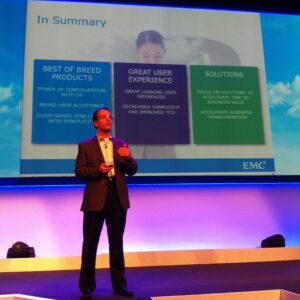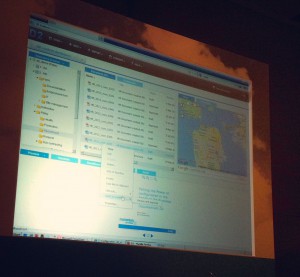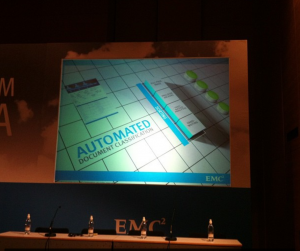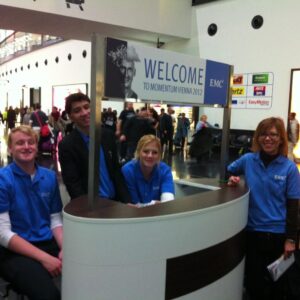This session was presented by Abhishek Srivastava and he started to hight three areas of improvement in Documentum 7:
- Lower TCO via Improved Performance
- Improved Content Intelligence
- Enhanced Trust & Security
This session was held by Dan Ciruli and David Le Strat. First up they presented the new unified designer tool in xCP which is model-driven and can be used to build the whole application. It really looks nice and is such an improvements from the days when we started with the Process Suite years ago.
My take on this is that xCP makes it easy to move model driven requirement repositories (UML, SysML, MODAF, BPMN) and connect to development in xCP designer.
Showed how dashboards was integrated in the UI where all information is visualised in context.
It is also where nice to see the search investments bearing fruit and in xCP 2.0 xPlore and CIS are integrated to power full-text searching with faceted navigation. I really like that content analytics is now a core concept they are talking about all the time. Big change from 2007.
Deployment is of course leverages through xMS and hyperic monitoring is connected to the virtualised environment. It is great to see IIG leverage other EMC products – it is about time. Agile development methods are already adopted in engineering which also will change release intervals. Expect releases twice a year, one around EMC World and the other at Momentum Europe.
IIG sees that the value proposition depends on the maturity level. First the focus is to cut costs but changes to things like improving customer communications and finally is about driving innovation. My personal reflection is that we are not that mature since most people are talking only about cost reduction.
Future direction
Finally they talked about the different versions of xCP and that there is no easy way to migrate from 1.x to 2.x since they basically are two different products. However, for version 2.1 there is a migration tool planned.
Time for the opening keynote in the big hall and what struck me first was that IIG reused the same sci.fi theme that was used at EMC World although with a “smaller” screen. The one in Vegas was huge! The theme is based on a spaceship tour that starts with “Transform IT”.
Guatam Desai, the new head of marketing for IIG was first on the scene. They showed some promotional videos from partners, one being around Atos launching Canopy. Next came Adrian McDonald, president EMEA of EMC Corporation. What struck me about his speech was how little he specifically talked about Documentum or IIG frankly. It is a recurring theme that when executives from non-IIG EMC talks at is almost exclusively about IT in general, some storage and volume of data. Talked about the software-defined data center and stated that we live in the Analytical Age. Reminded us that there will be more information created during the lifetime of a person born today than all of humanity to this date. Even the slide showing EMC acquistions over the years did not include Documentum. I think it is quite strange to stand in front of a crowd of IIG people and not adapt your message the slightest. The delivery was not full of passion either, unfortunately.
So, finally Rick Devenuti entered the stage and he brought some real passion to this keynote. He felt like “one of us” and he started off by announcing all the products.
Documentum 7
Highlights the much improved performance. Fast deployment through xMS which means that Documentum can be deployed in hours instead of weeks. Continued to explain how the concept of browsing which for long has been the cornerstone of ECM needed to be complemented with search. All this means that a lot has changed and to illustrate that he quoted CMS Wire:
“This ain’t your daddy’s Documentum”
Captiva 7
Rick chose to highlight continued focus on performance and scalability together with a new easy to use configurable UI together with increased accuracy.
Document Science 4.5
EMC’s tool for customer communications is also released in a new version with a new design client based on Microsoft Word among others things.
IRM 5.1

They started by defining what the New User really means:
“Clean, modern UI, access to info everywhere, on any devices, and wirh diversity of content types”
The move to D2 was because a realization of a more agile process away from traditional coding practices and towards easy instant configuration. As in Vegas people pointed out that it is not just about configuring the user experience but also a rules engine for content. One reason EMC acquired D2 was a realization that customers didn’t fit in the previous product boxes like knowledge worker, rich media, process etc. David also introduced an explanation of the difference between D2 and xCP which I think is the best yet:
xCP is configuration for “design-time” while D2 is config for “run-time”
The message was also that the usability that we all strive for comes when the UI is easy to use but also very easy to configure to different user’s needs. Today version 3.1 of D2 is consider the Power User tool but the plan is to move all these features gradually to 4.x releases of D2.
Future
Rich Media viewer aligned with xCP is planned (showed video preview with collection objects in a lower bar) as well as some Centerstage features.
Ver 4.1 is planned for Q2 2013 and include the following features:
When it comes to partner integrations things like the Brava viewer is supported in 4.1 and I think both an Active-X and HTML version of it.
Integration of the Euroscript reporting tool was also highlighted which of course make one wonder what the status is for Crystal Reports in the future. Earlier we saw a demo of Euroscript which featured reports in widgets that changed when interacting with other widgets in the UI.
Future D2 releases:
When it comes to mobile in the short term:
In the longer perspective they see mobile clients both leverage D2 and xCP configuration. Clients based on HTML 5 for multi-platform support. The ambition is to have mobile clients fully integrated with information management and governance.
Tuesday at the conference was divided into three industry tracks: public sector, energy & engineering and healthcare. In addition to that a developer tracks and two unnamed ones. I choose to attend the public sector track for the first and last session of the day.
The day kicked of with Ronnen Ronnen who is the Vertical Solutions Director for Public Sector in EMEA. His session “Public Sector trends and vision” was an overview of the issues and trends in our area. The main features of his speech were:
The main keywords for public sector seemed to be: services, processes, streamline, efficiency, simplification and re-engineering gov processes. Shrinking public sector budgets and needs to cut costs in IT seemed to be an important rationale. Depending on how you interpret things it seemed to be an IT perspective – minimize costs but what about deliver new capabilities rather than cheaper existing ones? Priorities for the public sector from this IT perspective was stated to be:
To me it seem important to distinguish WHAT measure you take from the underlying reasons WHY you them. From an IT perspective there is a risk of just focusing on delivering what we do know or at least they way we work now in a more cost effective way. I wonder for how long it will be enough not improving what the business do while doing it more efficiently. It boils down to how big of a picture you want or can take. Is it just IT meaning boxes and software or is it a more strategic take on how the organization does its business?
However, somethings need to be focused on the IT-perspective and relates to the actual ability to support the business with new IT-support, the time to market aspect is crucial not only to save money but also to make it in a reasonable time frame from the business perspetive. Ronnen summarized it like this:
“Sometimes the time to market is so long that when you deliver the people initiating it are no longer there”
That means a requirement to move to a more agile development process and of course the way Doumentum xCP is heading reflects that. They claim 5-10 times faster development cycles which really addresses these challenges. Other trends that adresses the challenges are:
Documentum D2 4.0 Tutorial

Monday afternoon was spent on a tutorial around Documentum D2 and the new 4.0 version. The new UI is very nice and would make it much easier to demo Documentum without excuses around its UI. As usual it is very impressive to see so many things being able to control from its configuration interface, hit save and it is available to users without a restart of anything let alone the whole server. Since we are running and R&D-activity this will it possible for us to try new concepts and settings out much much faster. However, today I discovered a few limitations in the current release. One is that the structure (layout) of a workspace need to be configured using a plain old XML-file. Sure it is far better than compiling and editing XML is not that difficult but still it will slow down development slightly. Fortunately a graphical interfaces is under development. That workspace structure file is then imported in the workspace configuration interface. Another limitations is that external widgets has only one-way communication which for instance mean that you can use coordinates in document metadata to position a map but not use the map as a search criteria. Support for two-way widgets is also under development and planned for the next release.
I look forward to see support for virtual documents and more collaboration widgets from Centerstage in the next release. As of now I at least spotted a widget called “CenterstageCommentWidget” in a drop down menu. I also like that nice large dynamic document previews are built with an option to go full screen just as Centerstage (and Alfresco Share). Another nice feature is that all lists for documents or audit events can be exported as Excel files.
fme Migration Center
Also had a chance to look further in fme Migration Center which is a really powerful enterprise tool that I see can solve several business problems for us. The most obvious one is of course supporting migrations between systems and during upgrades. However, it can also be used to support large imports of content from file shares, USB-drives etc. It includes powerful regex features to set filenames, metadata and folder structures in the target system. The product requires an Oracle database to run but for smaller migrations up to about 500k they seemed to think the Express Edition could be a choice for those on a budget. Another powerful features is the ability to set up a migration path and then run it in simulated mode with no commits to the actual repository.

Monday at Europe’s Momentum conferences are devoted to a partner conference (which is closed for customers) and some Fundamentals sessions for us “normals”. I choose to go to the Introduction to Intelligence Capture by Sean Bird mainly because enterprise capture is an area which is something I think I need to look into more. In our project we have focused on Documentum and ECM but leveraging Captive as weel seem to make sense. What strikes me is that paper is still around and that is something I see everyday at work as well. That way citing a 4 year old IDC report around issues with paper-based document management makes sense. Laurence (Word of Pie) reminded me last EMC World that we still produce digital content, print them just to scan them back into another system. Sean pointed out that scanners today is a proven technology but it actually took a while to get there.
EMC is a bit unusual as a company I think in they way it approaches other vendors and realizes the legacy IT environment. Some companies are almost religious in not mentioning other vendors at all and insist that their products are the only ones. Sure, EMC promotes their software portfolio and is getting much better in putting an effort into integrating their own products. Still they are very open to provide adaptors and plugins for other vendors which I think is great for us customers. It makes it somewhat easier to mix products based on our needs and have EMC supports us in that approach instead of constantly trying to promote their own stuff.
A thing that was new for me was that EMC owns the ISIS (Image and Scanner Interface Specification – ISIS) through Captiva. I also learned a new abbreviation this morning and that MFP (Multi-function Printer) and in plural MFPs of course.
This week in Vienna EMC will announce Captiva 7 which includes:
It is early Monday morning here in Vienna and I felt it was time to write a little summary post just on the brink of this years’ EMEA Momentum conference. This will be my third EMEA conference (attended Prague in 2008 and Berlin in 2011) but I have also been to five EMC World conferences, the last one in May this year. For me these conferences are something special since they are a unique opportunity to be around people caring and knowing about Enterprise Content Management. Customers with interesting problems but not the least people from EMC IIG Engineering who I have had so many great conversation with around ECM and Search. In my project we have some unusual requirements which are usually met with surprise or even skepticism by IT people, but usually not from EMC Engineering which is just great. EMC is not a perfect company but this provides a setting why I really like coming to Momentum every year, it is a vital place to recharge my innovations spirits. I have also been fortunate to share some experiences from our project as a speaker. So what do I expect from this years conference then?
First let me start with arriving in Vienna today. Just outside the entrance from baggage claim there was a nice booth welcoming us and providing us with guidance on how to get to our Momentum coaches. I think this is a nice touch that makes the trip more “seamless” to use some Apple language. It is not something I am used to from EMC World but on the other hand those conferences have grown to 15 000 people nowadays. I snapped a photo of the Momentum crew in the arrival hall:

Somehow it seems that the excitement this years is a bit higher than I am used to. Naturally I need to mention this blog post by Brilliant Leap that really gets the expectations flowing. Jed Spinks have even created an application in Documentum xCP to manage his Momentum information and let us access it. It seems that people expect that it will be a major launch during the event which of course that even CMS Wire will write something about Documentum 🙂
I agree that xCP version 2.0 will be in focus and rightfully so. It is way cooler than what most people (especially outside the IIG community) understands. I really look forward to see a stable version with all the major tools and interfaces integrated. Which brings me to the area I will cover most thoroughly, interfaces and end user features. I really, really hope to see good progress towards one unified user interface architecture and if they could merry D2 and xCP ExtJs-based interfaces would be great. However, I do hope that some Centerstage and some DAM/Media Workspace features finds its way to the new interface as well. As noted during EMC World I can’t get my head around why EMC IIG does not make that more of a priority. Documentum has the architecture to handle massive amounts of images and video and now when cameras and smart phones are everywhere there is an opportunity to provide “Flickr for the Enterprise” and “Youtube for the Enterprise” using Documentum. Make it fun and easy to manage rich media!
I also need to mention Next Generation Information Server (NGIS) as well. Jeroen’s thoughts around this is music to my ears but it would be nice to see some real progress in this area as well. At EMC World we got the message that NGIS was mainly focused on the cloud (OnDemand) side of IIG business while Documentum 7 would be the on premise way. However, mechanisms to easily move code from xCP in D7 to NGIS was a priority. I wonder if we could see some roadmaps on making NGIS the new unified architecture or maybe I am just dreaming? I really would like to run NGIS on premise on our project anyway.
Integration of other EMC software is another area of excitement and expectations from my side. First and foremost VMWare of course which seem to make the whole business of deploying and running Documentum something completely different than what we are used to. Not just virtualisation but also their custom tcFabric Tomcat application server is really interesting. RSA technology would be nice to see more and of course my favourite in the social area, Socialcast. I really want to see Socialcast being integrated both on the platform side as well as a the main way of providing activity streams inside xCP.
Well, that was some of my thoughts. See you at the conference and follow me on Twitter (Tweets posted here in my blog to the right).
The new thing this year is public and private cloud when it comes to Documentum and xCP. It took a while to release xCP 2.0 because they want to have a future-ready architecture.
Principles that have been used when designing xCP:
Complete application debugging
Key innovations:
XForms could not be customized design time because of the Forms engine. Had to be redesigned.
The performance of the stateless engine is really good – can more or less act as a real-time data source. Useful when designing responsive UIs.
xCP generates .war .dar and config-files into an application package
Customer experiences from Streetworx Contract Lifecycle Mgmt:
3 weeks development time for the application.
Builder is quite different from xCP 1.x tools with many new concepts. Documentation is in progress and tools is in process.
Possible to create relationsships between an object representing a contract and an object like a milestone. Powerful abstractions.
They liked that xCP has Web/Enterprise 2.0-style GUI.
No more jumping between the tools which is nice.
One button deploy/test in one tool leads to rapid development.
Changes are propagated throughout the environment.
HTML in widgets is appreciated since it enables a finer control of the UI.
Stateless process:
– no more adaptors
Define input and output and map them to widgets on your page. You can do much more than a single DQL query without having to write a custom adaptor
Result lists are vastly more powerful than 1.x read-only tables
Tritek experiences
Said it was important to not look at xCP 2.0 as an incermental release – it is more major than that.
Bad:
Leverage rich widget-based UI with ExtJS and the spring framework for agile solution delivery.
Big change was moving from structured data types to business objects
Big challenge for custom apps: No DFC equivalent for BO to replace SDT access
Large long-running workflows do not take advantage of xCP 2.0 features.
GA for xCP 2.0 is Q3 2012 – the time as D7
In xCP 2.1 they will have an importing feature that will upgrade some of the artifacts
the degree of manual vs automatic migration is not yet decided.
There is a technology convergence between D2 and xCP user interface technology.
Will there be a developer edition? Not yet decided.
The purpose of xCP is a targeted application which is specific which is different from the existing horisontal mobile application such as Documentum Mobile.
The web application will work on web browsers in mobile. Took out flash, active-x etc which makes it possible.
Possible to generate a set of services and then hook that up to a mobile application which is purposebuilt using iOS or Android.
xCP requires Documentum 7.
A record setting 15000 people at EMC World this year meant that the keynote session was bigger than ever. Designed around a space/scifi theme by CMO Jeremy Burton it was really impressive to see. A giant continuous curved screen covered the whole front of the area.
CEO Joe Tucci talked about his view on the radical shift in computing we see right now. Moving into a cloud era which he think is a bigger shift than any previous.
Followed by Pat Gelsinger the focus was as usual around things that make noise – big boxes. Not a word about IIG and Documentum in the keynote basically. A bit sad because it is seem to be a general issue that “traditional” IT-people only care about what is below the database. Unfortunately it is also the stuff that business people understand easily. Things that make a noise and you can touch. More abstract things like metadata, processes you find in enterprise content management seem to be harder to get and definitely harder to touch. Maybe not as sexy as big sic-fi looking boxes with huge hard drives either. A good show it was though.